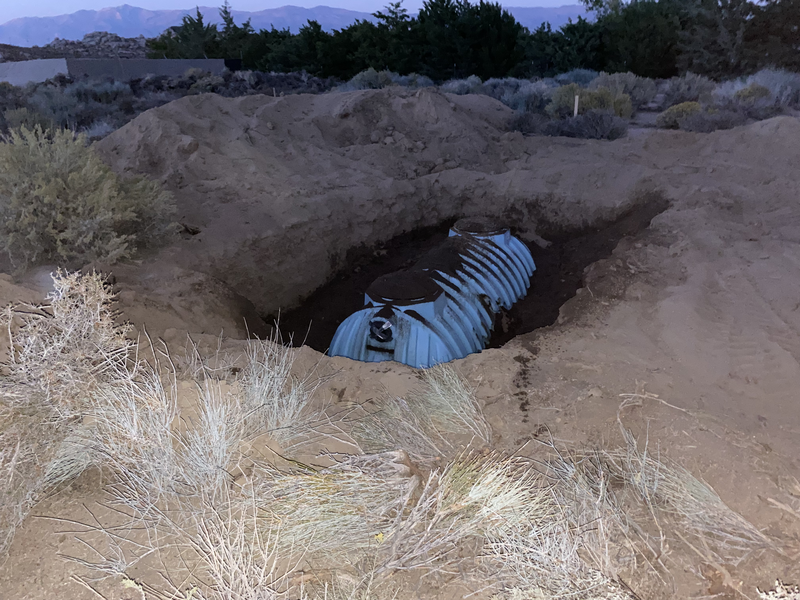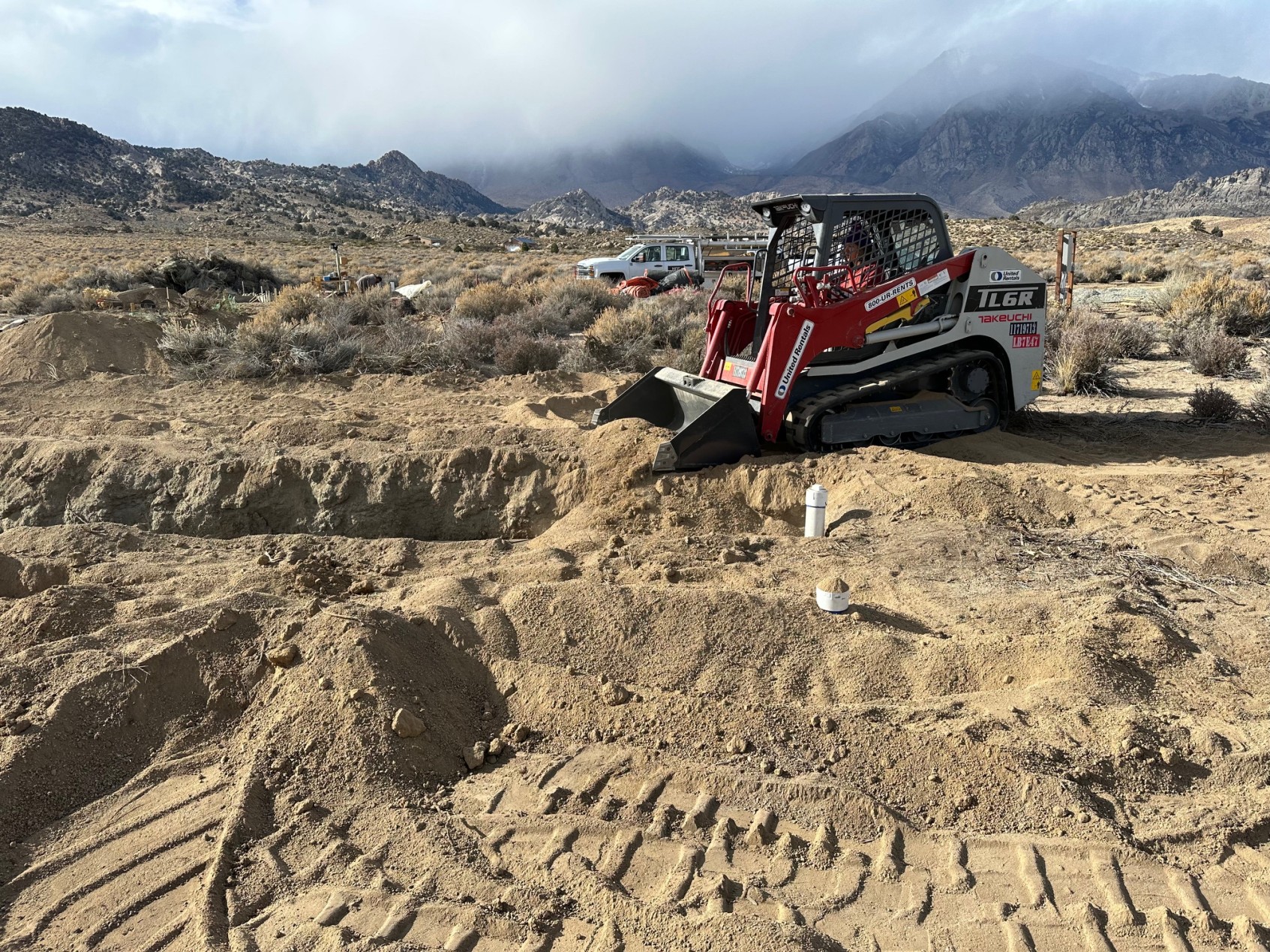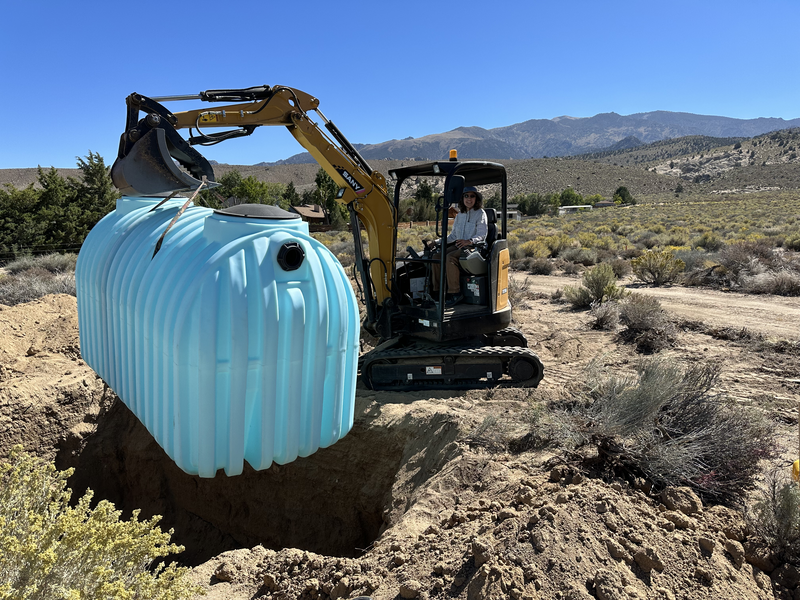Back when we were extending the main water line to our property and rented the mini-excavator, I asked the county’s Environmental Health Department if I could dig the hole for the septic tank. They were quite busy this summer and hadn’t approved or commented on my septic permit yet. They said, yes, we could dig the hole and set the tank I specified. Great!

So I dug the hole. For such a big hole, it is good to plan ahead how the excavator will move, where to start and end the rows that make up the whole hole, and where to put dirt. I mostly got it right.

Then I leveled the bottom of the hole by hand. The Zip Level Jon bought was very useful to get the absolute elevation of bottom of the tank just right. And I’m a dorky engineer, so it appears it was made for my kind.

I was nervous about setting the tank down in the deep hole because the excavator is a little tippy when its arm is extended with weight in the bucket. Jon brought the tank over to the hole with the tractor. I v… e… r… y… slowly extended and lowered the tank down.

Then I pushed the tank around to get it to line up with the stakes we had set for future main drain and leach field. Then filling and compacting a bit to keep it in place. I learned how by reading the micro-instructions included with the tank and watching a youtube video. One neighbor said, “You can’t learn that kind of stuff by watching youtube videos,” like I was some kind of experienced person. I just smiled.

After we completed the main water extension and the owner picked up the mini-excavator, Jon used the tractor’s backhoe to dig the maze of water and septic drain lines. Talk about planning the order and direction of digging! Not my finest design, but Jon did great!

We installed the pipe for both water and drain. The septic drain lines have to be 2% slope so things will drain to the tank. The water lines are not as particular because the community water system is pressurized (there are huge tanks up the hill.) The water line could go over and under the drain line, as needed, as long as it remained below frost line.

Our trenches passed inspection from the Building Department, so we bedded the pipes in nicely and then filled and compacted them. At this point we had frost free yard hydrants and shut-offs at each water terminus and two-way clean-outs at each septic stub. I checked on our septic permit and it was approved, but they wanted inspections at two different stages instead of one because it isn’t common to do an old fashioned rock leach system anymore. Everyone around here uses the proprietary Infiltrator system nowadays. I think that new system has more expensive parts and less expensive labor, but my labor is free, so bring on the cheaper materials!

When the concrete contractor came, he brought a mini excavator, so I asked for him to dig the line exiting the septic tank and the two leach lines. For the distribution box, I wanted a gravity dosing box because it is a simple way to extend the leach lines’ lives. It holds the liquid until there are a few gallons, then releases at once so more than one perforation in the pipe gets used each cycle. Drizzles of water can favor and overuse a couple holes.

The tractor died again, so I rented a skid steer and had a lot of fun loading the trenches with 2′ of 1.5″ clean rock and generally speeding around. Who doesn’t love tracked vehicles? Jon helped me with the gasketed perforated pipe because he is the gasketed pipe expert of the family.

Then several more inches of rock, then geotextile fabric, then dirt.

While I had the skid steer, I also prepped the parking area for the tiny house trailer by leveling it and spreading 7/8″ rock over geotextile fabric (I was able to reuse the fabric we used as a lizard and beetle rescue cover for our solar system holes.) And filled the dry well with rock, fabric, and dirt, too. I barely finished with the skid steer before the week-long rental was over. Whew!

Our septic inspector said, “This should last forever,” and approved it. At this point, we had 2 out of 3 things we needed to move the tiny house up and live on our property. Even though none of the other lyrics apply, I had the refrain from Meatloaf’s “Two Outta Three Ain’t Bad” in my head for a few days, hahaha!

